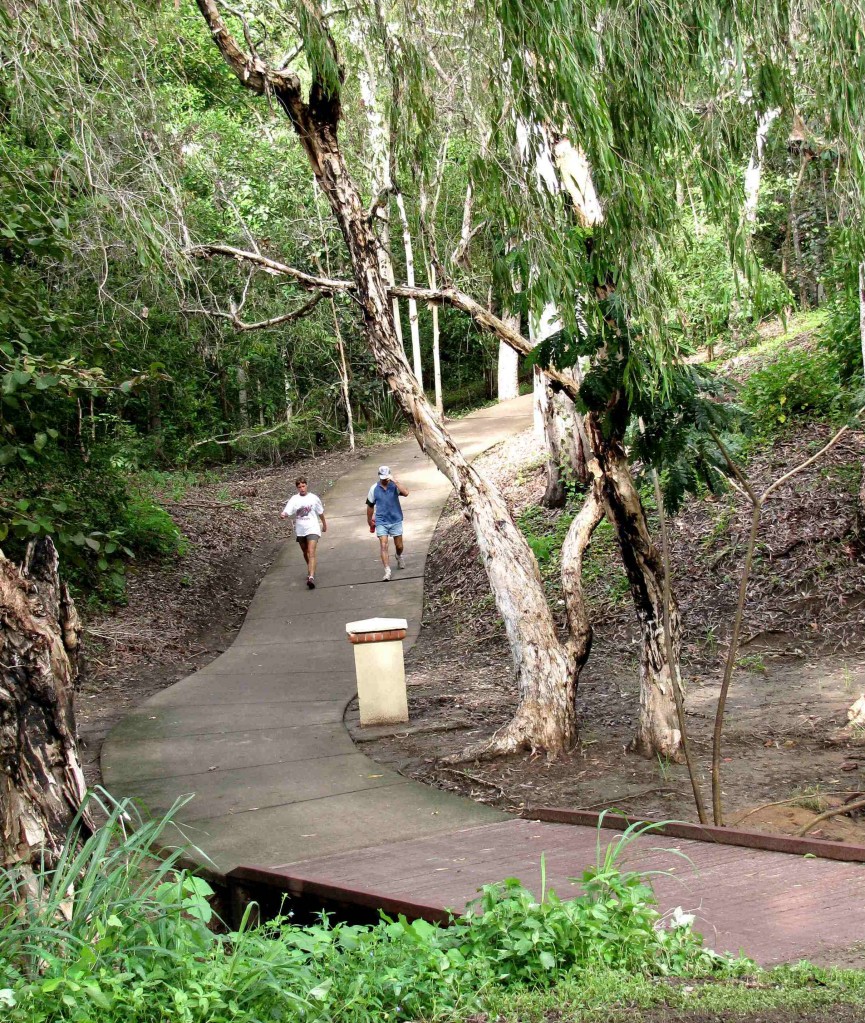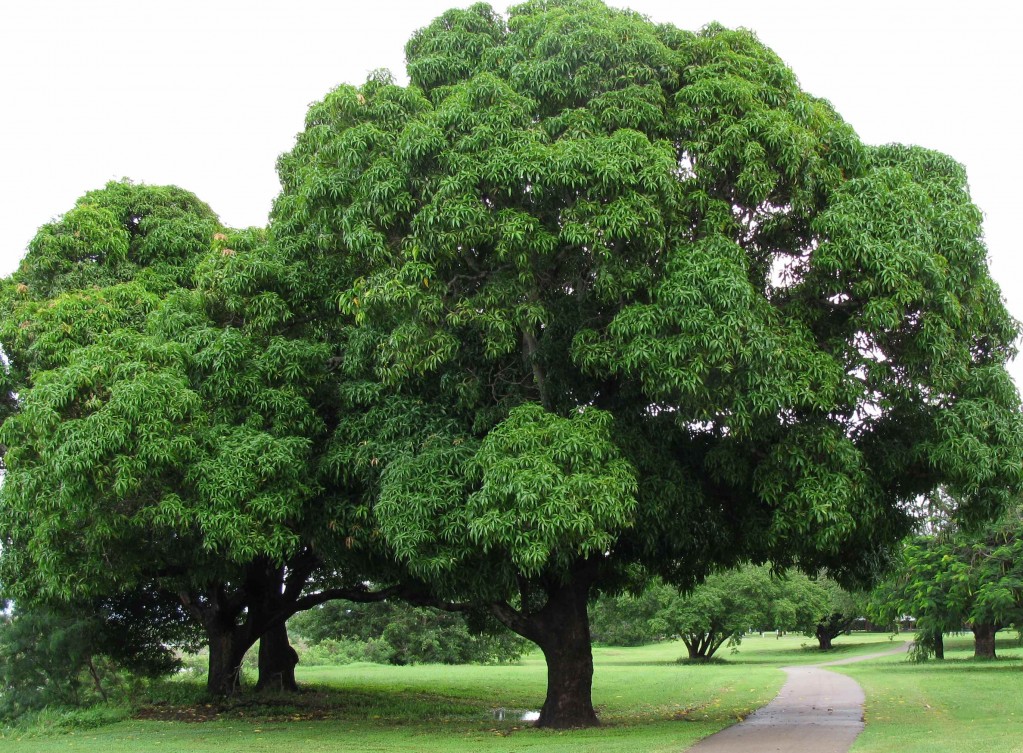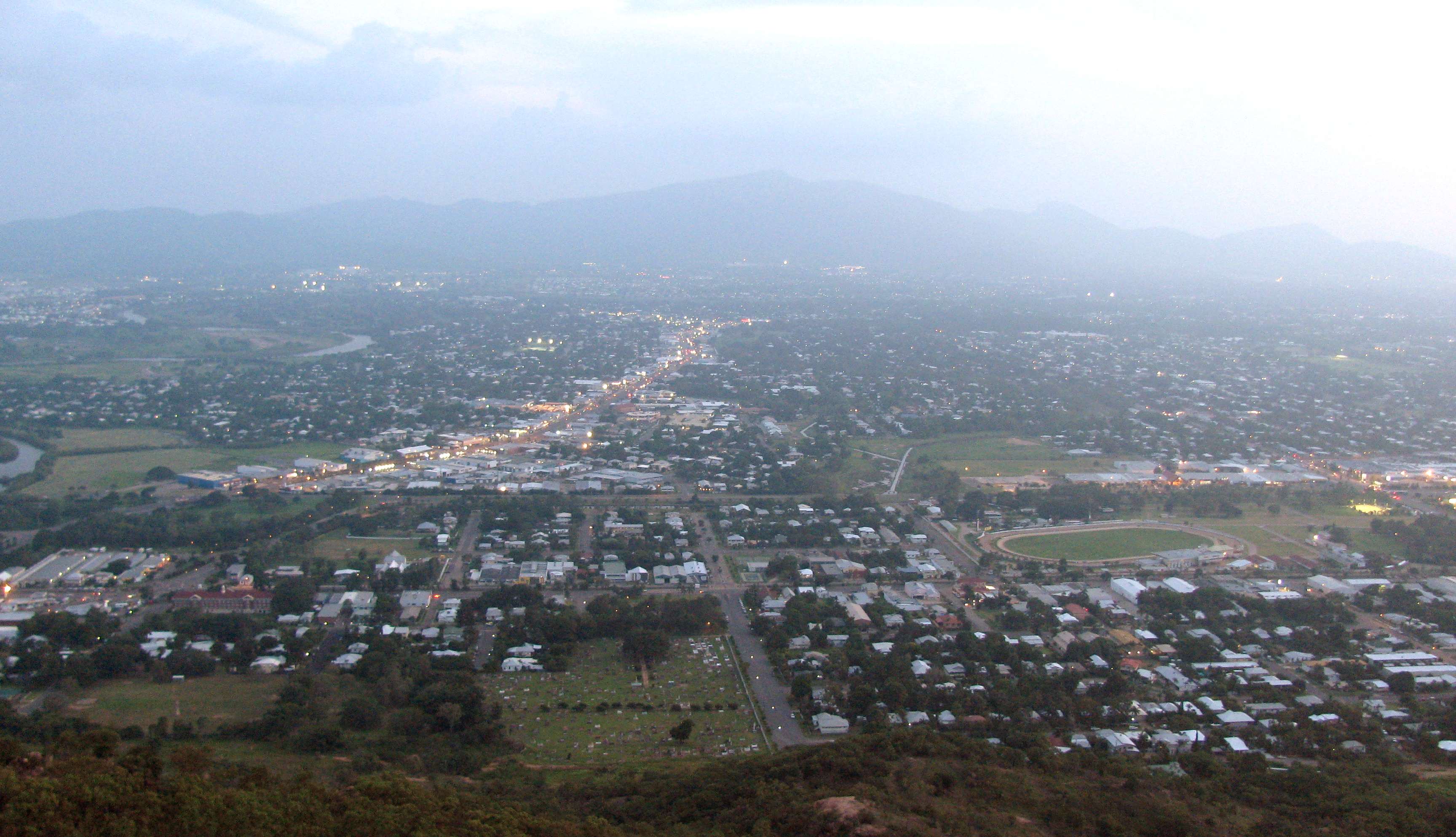
Dips & Curves in Douglas Park suburb, Townsville (© Magi Nams)
In the lifting darkness of 5:30 a.m., my bicycle light cast a white beam onto the paved path beside the golf course as I rode south in the Ross River Parkway. Sprinklers on the golf course pushed long silver arcs of water out onto the grass. Overhead, flying foxes flapped their quick, stiff wing beats, heading east to their camp at the mouth of the Ross River and a day of rest.
From the parkway, the river was a mirror touched with gold from the impending sunrise. The shapes of lush shade trees bulged downward onto the glassy surface as well as upward into the sky. I crossed Aplin’s Weir and felt faint spray from the measured spill of falling water touch my skin. Then I cycled on past Palmetum Park and Nathan Street Bridge into the suburb of Douglas Park, where twisting curves on short, sharp dips and rises stole away any remaining drowsiness and had my quads straining. When I retraced my path, I met a quartet of young women cycling into the park. One of them excitedly told a companion, “This is the fun part!” She was right.

Mango Trees in Ross River Parkway (© Magi Nams)
On my return ride through the more sedate, but undoubtedly grander section of the parkway that leads to Aplin’s Weir and Bowen Road, I observed the lush mango and rain trees with new, somewhat pained eyes, for not only do these parkway giants provide welcome shade and, in the case of the rain trees, stunning beauty, they also provide resting places for mosquitoes. I learned this from ABC radio last evening. It was a strange coincidence that, at the time the radio was spewing forth fever-mosquito information, I was reading in the Townsville Sun that next week the city will declare an end to its dengue fever outbreak, since the mandatory 3-month period from the last time a locally-acquired dengue case was reported will elapse on March 6. Being bombarded by mosquito-related information from two sources, I sat up and paid attention.

Male Red Kangaroo (Grey Phase) (© Vilis Nams)
From the sources mentioned (and others researched later), I learned that Aedes aegypti is the main mozzie culprit carrying the dengue fever virus, and that Queensland is the only part of Australia to suffer from dengue fever, with recent local cases suspected as all arising from individuals who were infected elsewhere in the tropics.1,2 Ross River fever and Barmah forest fever, on the other hand, are viral diseases spread by several species of mosquitoes and occur throughout Australia every year.1 The Ross River and Barmah fever viruses occur naturally in kangaroos and wallabies, and when these mammals are fed upon by mosquitoes, the viruses are transferred to the insects. 1 All three of these mosquitio-borne viruses incubate for about a week and are subsequently passed on to whatever prey the infected mosquitoes feed on next. 2 Although scientists have developed a genetically modified female Aedes aegypti mosquito that is flightless – a development that will hopefully curb the spread of dengue fever in the future3 – the best defence against Ross River fever is limiting possible breeding places. Hence the regulations about not having water laying around.

Palm Leaf Cup (© Magi Nams)
After I returned to the house, I did a yard inspection, looking for large fallen leaves or any other kind of container holding standing water. I collected a half dozen or more fallen palm leaves, the bases of which form long-mouthed cups. All were dry, but during a prolonged period of wet days, one with a leaf base cup open to the sky would form a perfect mosquito breeding site. Shortly after I went inside, I heard a loud thud of something falling onto the front patio. On investigation, I saw a huge dead palm leaf on the cement, its leaf base open to the sky and forming a natural receptacle for both rainwater and mosquitoes.
Hours later, beyond the reach of Townsville’s heat-melded day, Vilis and I drove up Castle Hill, dodging a few other cars and a startling number of runners, cyclists, and walkers on the long switchback leading to the summit. “I wonder if it’s like this every evening,” Vilis mused. The Ross River Knights paled in comparison to that crowd.
Blue haze draped the Many Peaks Range and the sky above it, dashing our hopes for a gorgeous tropical sunset viewed from the peak of the hill. Our disappointment was assuaged by a fresh wind that blew in off the ocean, tickling and tossing the flower plumes of rock-loving grasses and inviting us to laughingly lift our arms to its cool caress. As we walked from one lookout to another, the lights of the city lit the thickening darkness until the floodplain lay like a gem-studded cape encircling the base of Castle Hill and spreading far into the distance. Through the haze, we discerned lights far offshore and realized they belonged to two of Magnetic Island’s small villages.
During the short descent from the lookouts to the summit car park, the fresh ocean wind abandoned us, sailing overhead and instead leaving us to the dense, warm humidity of another Townsville summer night. The road climbing the hill seemed so empty on the way down, the car’s headlights picking out only a handful of walkers striding downward near the tall, green grasses, boulders, and overhanging eucalypts that adorned its edges.

View to South from Castle Hill at Dusk (© Vilis Nams)
References:
1. ABC Health & Wellbeing. Fact File: Ross River Fever. © 2010 ABC. Updated 19-Jan-2006. Accessed 23-Nov-2010. http://www.health.qld.gov.au/goodhealthintnq/topics/mosquito.asp
2. Shalinie Perera. Mosquito-borne Illnesses. QML Pathology. Apr-2010. Accessed 23-Nov-2010. http://www.qml.com.au/Files/Mosquito-Borne_Illnesses_Flyer_814.pdf
3. JoAnne Allen. Flightless mosquitoes may curb dengue. ABC Science, February 23, 2010. Accessed 23-Nov-2010. http://www.abc.net.au/science/articles/2010/02/23/2827548.htm


